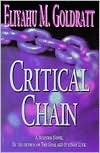

 |

|

The average rating for Critical Chain based on 2 reviews is 3.5 stars.
Review # 1 was written on 2015-08-11 00:00:00 Dustin Abolafia Dustin AbolafiaThis book is really hard to evaluate for me. Probably due to my background in agile software development. I secretly hoped the Critical Chain method to provide logical proof to the agile community's intuitive findings. But it didn't. Critical Chain covers a few important topics: fallacies of estimation, ways to create safety buffers, ways those buffers can fail, danger of multitasking, importance of optimizing for the lead time. It puts a firm nail into the coffin of more traditional project management approaches, that's for sure. It also highlights (and overcomes) the business schools' inability to teach relevant management know-how, applicable in the industry. Speaking of the narrower field of software development, Critical Chain missed a huge opportunity that agile movement has demonstrated: Delivering value in small regular increments and by doing that allow the investment decision be incorporated into the development cycle itself. In the ToC lingo, agile questioned the assumption that the value of the project can only be delivered as a whole. This assumption may still be valid in some domains, where Critical Chain will be tremendously helpful. One won't probably want to build a huge car park far away from a city without committing to build a whole airport. |
Review # 2 was written on 2008-12-03 00:00:00 Georgia Ringelberg Georgia RingelbergAs an Engineer I am used to reading highly structured texts where the content is clearly partitioned into numbered sections with a series of formulas and figures to present the theory. After reading the theory in each section, I'll typically find a number of problems designed to test and enrich my understanding before proceeding to the next topic. Eliyahu Goldratt, who is a physicist turned business consultant, chose to break from this conventional writing style by presenting his ideas in the form of business novels. Goldratt's most famous novel is called The Goal - A Process of Ongoing Improvement. Critical Chain applies the Theory of Constraint principals presented in The Goal to Project Management. If you have not read The Goal, I highly recommend you read it, however it is not a prerequisite to understand the book Critical Chain. Goldratt's novels begin by introducing a lead character and then a number of additional characters that tie into the lead's personal and professional lives. As the characters are presented, the reader learns about their various problems and their need for finding solutions. The reader then follows the characters through their journey of defining the problem and learning new ways to look at the problem along with demonstrations of how the conventional views of the problem unexpectedly lead to solutions with less than desirable results. The journey then continues with the characters finding and implementing successful solutions to their problems. Interestingly, some of the subplots in the lead's personal life foreshadow lessons to be learned in his professional life. And often after solving the business problem, the character learns to apply the new techniques back to his person life and other problems he had not expected. The Critical Chain revisits the Theory of Constraints principles from The Goal and applies them to problems in Project Management. As an example, the reality of uncertainty in time estimates for an activity is presented. Usually 'safety' is added to the estimate to ensure enough time is allocated. However this can lead to the 'student syndrome' where an activity will be left to the last minute if given the opportunity. This 'student syndrome' is not always bad and in particular cases should be encouraged. If you are familiar with The Goal and its definition of the concepts of throughput, inventory and operating expense, you may be able to anticipate how these concepts, which were applied to the manufacturing plant, should be applied to Project Management. However some of the relationships are subtle and the differences are important. To me, applying the Theory of Constraints to Project Management is analogous to applying vibration theory of a mechanical system (mass, damper and spring) to an electrical system (inductance, resistance and capacitance). If you are familiar with these physics concepts, you know that it is useful to apply your experiences with a dynamic electrical system to your experiences with a dynamic mechanical system and vise versa. But you must be careful in your comparisons if you want to derive meaningful results. The same can be said when comparing the flow of material through a manufacturing plant and the flow of completed milestones in a project plan. I encourage you to read the book to fully appreciate this. Goldratt's approach of telling a story to teach his audience is not new. However, it is not common in my experience. His style is a welcomed change to conventional textbooks and is effective. Later after being sold on Goldratt's techniques you can refer to one of the many conventional texts that were written after The Goal and Critical Chain to enrich your understanding. (For example Synchronous Manufacturing: Principles for World Class Excellence by Umble and Srikanth or Project Management in the Fast Lane by Robert C. Newbold) |
CAN'T FIND WHAT YOU'RE LOOKING FOR? CLICK HERE!!!